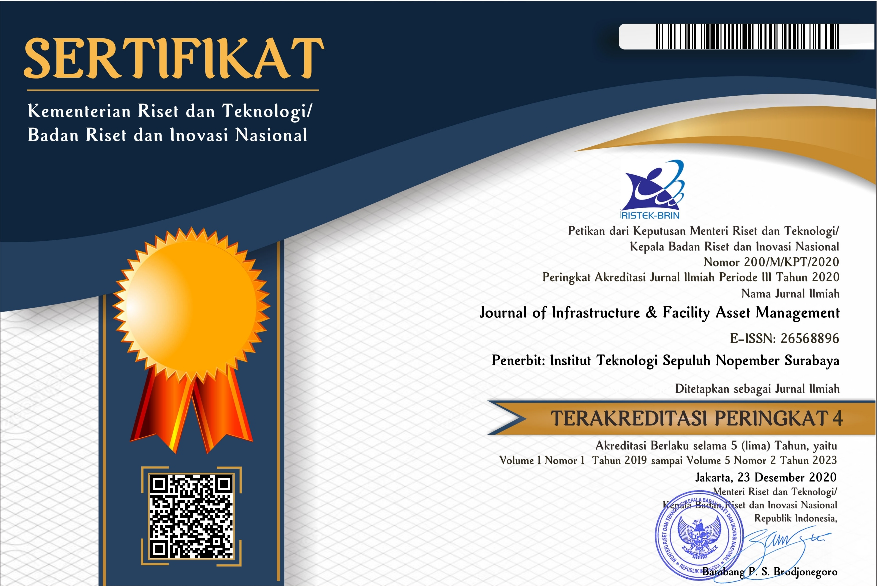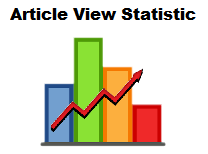Buoyancy and Stability Analysis of Ark’a Modulam Amphibious Foundation Model
Abstract
To solve problems of settlement in floodplain areas, research on anti-flood foundation model is crucial. The anti-flood foundation model should be able to float during flood and to remain on land during non-flood conditions. This research focused on an amphibious foundation model named Ark’a Modulam. The reliability of Ark’a Modulam floating construction was analyzed for buoyancy and stability against vertical and horizontal loads. Two floating constructions were designed based on knock down and rigid systems. Both systems were designed using iron pipes with 2.5” and 4" of diameter. No significant differences were found in the buoyancy forces of the 2 floating construction systems. The load that can be supported by 1 floating construction was a maximum of 0.954 ton and stable at a floating depth limit of 43.2 cm. The stability of the floating construction should include the effect of vertical drive piles. The vertical and horizontal loads acting on the construction positioned inside Kahayan River during an extreme flood was also analyzed. During an extreme flood with 100 years of return period, the construction of one vertical drive piles should able to support vertical forces equal to or larger than 7.50 ton.
Full Text:
PDFReferences
Abbot, I.H., & Von Doenhoeff, A.E. (1959). Theory of Wing sections. Including Airfoil Data. Dover Publications. Inc. New York.
Junqiang, X., Teo, F. Y., Lin, B., & Falconer, R.A. (2011). “Formula of incipient velocity for flooded vehicles”. Nat Hazards. Vol. 58, pp. 1–14.
McCormick, & Barnes, W. (1979). Aerodynamics, Aeronautics, and Flight Mechanics. John Wiley & Sons, Inc. New York.
Nomeritae, Yupi, H. M., & Afentina. (2018). “Rekayasa Hidraulik untuk Pengendalian Erosi dan Sedimentasi Ruas Sungai Kahayan Berstruktur Membentang Sungai”. Jurnal Teknika. Vol. 2, No. 1, pp. 1-12.
Powell, & Gabe, W. (2009). Identifying Land Use/Land Cover (LULC) Using National Agriculture Imagery Program (NAIP) Data as a Hydrologic Model Input for Local Flood Plain Management. Texas State University. Texas.
Suprayitno, H., & Soemitro, R.A.A. (2018). “Preliminary Reflexion on Basic Principle of Infrastructure Asset Management”. Jurnal Manajemen Aset Infrastruktur & Fasilitas, Vol. 2, No. 1, pp. 1-9.
Waluyo, R., Wijanarka, & Nomeritae (2019). “Estimasi Biaya Konstruksi Pondasi Anti Banjir”. Prosiding SNSRT. Fakultas Sains dan Teknologi, Universitas Pelita Harapan. Tangerang.
Wijanarka & Waluyo, R. (2017). “The Innovation of Flood Resistant Foundation: Development Study And Reliability of Ark’a Modulam (Module of Amphibious), With Various Floating Materials Through The Model Physical Test”. International Conference on Architecture 2017 (ICRP-AVAN), pp. 106-111. Unsyiah. Banda Aceh.
Wijanarka, Waluyo, R. & Nomeritae. (2019). “Experimentation for Development for Ark'a Modulam Foundation as an Alternative to Create Amphibious Architecture in the Urban Floodplain in Kalimantan”. Indian Journal of Science and Technology. Vol. 12, No. 19, pp. 1-15.
DOI: http://dx.doi.org/10.12962/jifam.v2i1.6906
Refbacks
- There are currently no refbacks.
Visitor :
Flag Counter

Journal Of Infrastructure & Facility Asset Management by Institut Teknologi Sepuluh Nopember is licensed under a Creative Commons Attribution-ShareAlike 4.0 International License.





